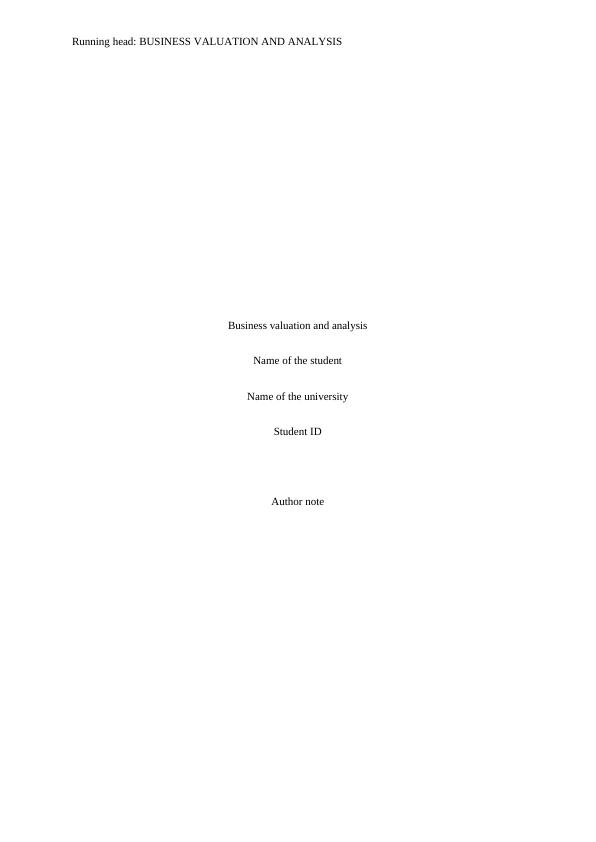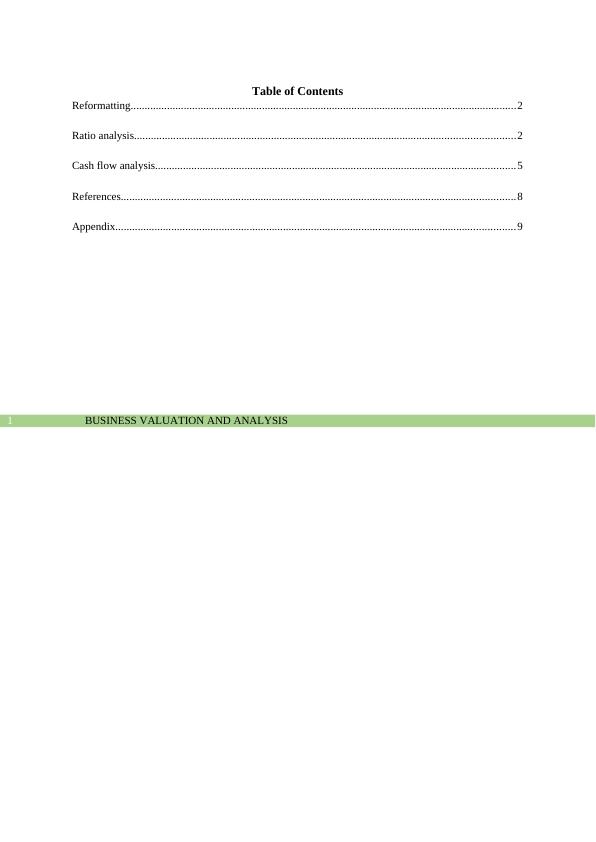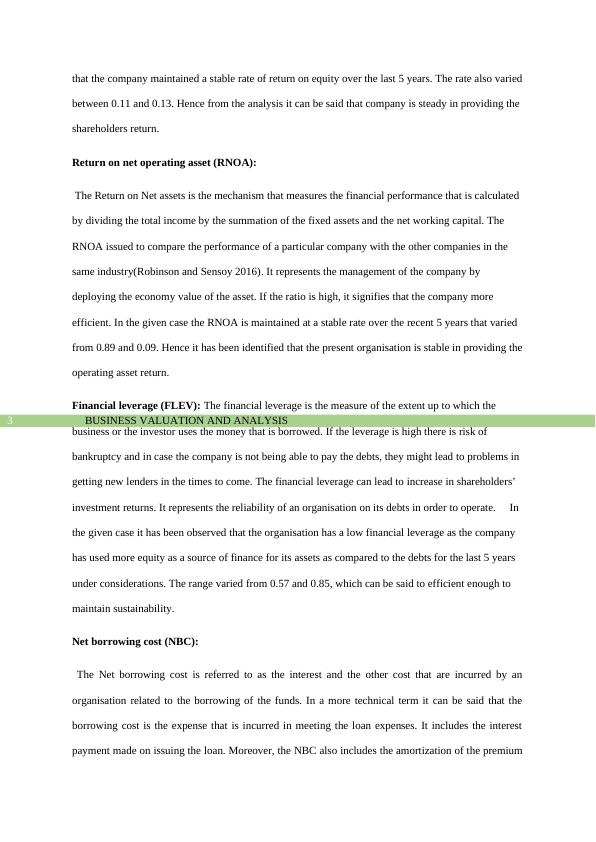Business Valuation and Analysis - Doc
Added on 2021-06-17
13 Pages2859 Words19 Views
Running head: BUSINESS VALUATION AND ANALYSISBusiness valuation and analysisName of the studentName of the universityStudent IDAuthor note

BUSINESS VALUATION AND ANALYSIS1Table of ContentsReformatting..........................................................................................................................................2Ratio analysis........................................................................................................................................2Cash flow analysis.................................................................................................................................5References.............................................................................................................................................8Appendix...............................................................................................................................................9

BUSINESS VALUATION AND ANALYSIS2ReformattingRefer to appendix and Excel sheetRatio analysisRatioFormula20172016201520142013Return on equityNet income/shareholders equity0.110.120.130.120.11Return on net operating assetNet Income/Net operating asset0.080.080.090.090.08Profitability marginNet profit / sales *10013.0511.4016.4215.7512.56Asset turnover ratioNet sales/Total assets0.520.570.500.490.53Financial leverage ratioTotal debt/Shareholder's equity0.600.850.640.570.61Net borrowing cost ratioNet financing expenses/Average netfinancial obligation0.020.020.020.030.03201720162015201420130.002.004.006.008.0010.0012.0014.0016.0018.00Ratio analysisReturn on equityReturn on net operating assetProfitability marginAsset turnover ratioFinancial leverage ratioNet borrowing cost ratioRatio analysisReturn on Equity (ROE):The Return on Equity refers to the measure of the profitability of the business related to the book value of the shareholders equity. It represents the measure of how well the organization uses its investments in order to generate the growth of the earnings (Kroes and Manikas, 2014). It is also known as net assets or net minus liabilities. From the observation of the above operation it can be said

BUSINESS VALUATION AND ANALYSIS3that the company maintained a stable rate of return on equity over the last 5 years. The rate also variedbetween 0.11 and 0.13. Hence from the analysis it can be said that company is steady in providing the shareholders return. Return on net operating asset (RNOA):The Return on Net assets is the mechanism that measures the financial performance that is calculated by dividing the total income by the summation of the fixed assets and the net working capital. The RNOA issued to compare the performance of a particular company with the other companies in the same industry(Robinson and Sensoy 2016). It represents the management of the company by deploying the economy value of the asset. If the ratio is high, it signifies that the company more efficient. In the given case the RNOA is maintained at a stable rate over the recent 5 years that varied from 0.89 and 0.09. Hence it has been identified that the present organisation is stable in providing theoperating asset return.Financial leverage (FLEV): The financial leverage is the measure of the extent up to which the business or the investor uses the money that is borrowed. If the leverage is high there is risk of bankruptcy and in case the company is not being able to pay the debts, they might lead to problems in getting new lenders in the times to come. The financial leverage can lead to increase in shareholders’ investment returns. It represents the reliability of an organisation on its debts in order to operate. In the given case it has been observed that the organisation has a low financial leverage as the company has used more equity as a source of finance for its assets as compared to the debts for the last 5 years under considerations. The range varied from 0.57 and 0.85, which can be said to efficient enough to maintain sustainability.Net borrowing cost (NBC): The Net borrowing cost is referred to as the interest and the other cost that are incurred by anorganisation related to the borrowing of the funds. In a more technical term it can be said that theborrowing cost is the expense that is incurred in meeting the loan expenses. It includes the interestpayment made on issuing the loan. Moreover, the NBC also includes the amortization of the premium

End of preview
Want to access all the pages? Upload your documents or become a member.
Related Documents
Accounts Assignment- Computershare limitedlg...
|14
|2391
|43
TABLE Westpac Banking Corporation 2018 Sales Revenue Rate oflg...
|2
|365
|59
ACC600 Accounting Fundamentals Managementlg...
|16
|3714
|78
Financial Analysis of Pensonic and Panasoniclg...
|10
|1495
|228
Managing Finance: Analysis of Financial Information and Stock Valuationlg...
|10
|2016
|47
Financial Analysis of Vodafone and Comparison with Deutsche Telekomlg...
|14
|2428
|226
